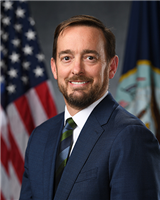 Mr. Christopher Miller, Executive Director, Naval Sea Systems Command
Mr. Christopher Miller, Executive Director, Naval Sea Systems Command
At the April 22nd VSRA General Membership Luncheon, our guest speaker Christopher Miller, Executive Director of Naval Sea Systems Command, delivered a compelling address outlining the Navy’s current challenges and NAVSEA’s strategic response. Speaking to a room of VSRA members, Miller offered a data-driven snapshot of where the Navy stands and where it must go.
Miller began by framing the Navy’s position within a growing environment of global strategic competition, particularly pointing to China’s integration of military and commercial shipbuilding. He warned that while the United States maintains an advantage in quality, adversaries are closing the gap by building faster and leveraging commercial infrastructure for military ends. “2027 is not some distant milestone,” Miller said. “It is within our current budget window, and we are not going to be able to buy our way out of this. We’re going into the next fight with the fleet we have.”
His speech centered around five priority areas: ship construction, maintenance readiness, data utilization, workforce resilience, and infrastructure modernization. On ship construction, Miller acknowledged that while over 50 ships are currently in the pipeline, but only a handful are on schedule. He described the need to find a modern equivalent to the World War II–era Liberty ships, being simple, fast-to-build vessels that can help restore mass and flexibility to the fleet.
Maintenance readiness took center stage as Miller revealed current submarine maintenance is “at zero percent on-time completion,” a statistic that drew visible concern from the room. He praised improvements in the surface fleet, attributing progress to smaller, more frequent availabilities that mirror commercial best practices. However, he made it clear that significant gaps remain, particularly in workforce availability and material provisioning.
Miller emphasized the need to leverage data and artificial intelligence, stating that NAVSEA collects massive amounts of information but has yet to effectively harness it. He called for more predictive planning and smarter sequencing of work, inviting industry input on how to convert data into action.
Workforce shortages were described as a severe constraint. Across NAVSEA, offices are on average ten percent below required staffing, with particularly acute losses among contracting officers and technical authorities. Miller acknowledged that recent retirement offers, though financially sensible for employees, have left operational gaps that are slowing progress.
He closed with a call for infrastructure investment, not only in piers and dry docks, but also in digital systems and industrial facilities. “These are not flashy projects,” Miller said, “but they are the foundation for everything else. We’ve underinvested for too long, and now we’re feeling the impact.”
Throughout the speech, Miller invited industry feedback and collaboration. He announced plans to begin publishing monthly fleet readiness data and expressed strong support for technology adoption, including cobots, additive manufacturing, and continuous maintenance models. He stressed that innovation must be coupled with urgency, and that NAVSEA is creating new structures to remove internal barriers to progress.
Miller concluded by stating that NAVSEA intends to improve the consistency and availability of performance data for shipbuilding and maintenance. This initiative is aimed at improving internal planning and enabling greater alignment with industry partners.
The presentation provided attendees with detailed insight into NAVSEA’s operational landscape and the areas where public-private coordination will continue to play a central role.
« Return to Newsletter